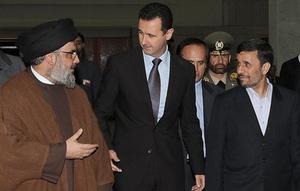SyriaHezbollah increases role as protector of the Assad regime
With the anti-regime uprising in Syria evolving into a full-fledged ethnic conflict between the Alawite minority and the Sunni majority, the Assad regime relies more and more on Shi’a allies – Iran, Hezbollah, and the al-Maliki government in Iraq — to stay in power. Over the last three months, Hezbollah has been playing a growing, and more open, role in shoring up the regime.

Hezbollah and its Shi'a sponsors take a larger role in supporting Assad // Source: wadize2ab.com
The anti-regime agitation in Syria began, in February 2011, as part of the broader campaign in the Arab world, which came to be called Arab Spring, for more openness and democracy. The autocratic regimes in Tunisia and Egypt were replaced with more Islamic regimes, while in Libya and Yemen the removal of the ruling dictators brought to power weak and fractious governments whose longevity and stability are not assured.
In Syria, however, the uprising soon developed into a full-fledged ethnic conflict between the Alawite minority and the Sunni majority. The Alawites have been in power since 1970, when Hafez al-Assad, Bashar’s father, seized power in a coup. Other minorities in Syria – Christians, Kurds, and Druze – largely support the Assad regime, as do some business-class Sunnis.
The problem for Assad is this: since the anti-regime rebellion has evolved into a clear-cut ethnic conflict between the Alawites and the Sunnis, he can no longer trust the loyalty of the majority of his military, which consists of Sunni conscripts.
Haaretz reports that the solution he and his Iranian allies have found is to enlist Hezbollah, the Lebanese Shi’a organization (the Alawaites are an off-shoot of the Shi’as).
Over the last three months, Hezbollah has been playing a growing, and more open, role in shoring up the Assad regime. Military analysts note the following:
Hezbollah has about 5,000 well-trained fighters (trained by Iranian officers), and about 15,000 less well-trained reserves.
Hezbollah has so far sent to Syria about 2,500 of the organization’s best-trained fighters.
Hezbollah has so far lost about 300 dead in fighting in Syria
Iran and the Assad regime have assigned Hezbollah four military missions of strategic value:
- Protect the corridor from Damascus in the south to Homs, Hama, and Aleppo in the north – three cities still largely under the control of the Assad government. Sending a large Hezbollah contingent to the area has helped the Assad regime make gains near the city of Al Qusayr near Homs. The rebels were hoping to gain control of Al Qusayr, thus disrupting the territorial connection between Damascus and the Alawite enclaves in northwest Syria, but the combined forces of Hezbollah and Alawite units of the Syrian military pushed the rebels back. About 5,000 rebels are now encircled by pro-regime forces in the vicinity of Al Qusayr
- Hezbollah fighters, joined by soldiers from Iran’s Revolutionary Guard, have also been assigned to protect the regime’s chemical weapons storage facilities, and the military bases where the regime’s more sophisticated missiles are kept.
- Hezbollah’s soldiers now also protect the organization’s large arms storage depots inside Syria. Following the destruction by the Israel Air Force of much of Hezbollah’s advanced arms in the opening hours of the 2006 war between Hezbollah and Israel, the organization decided it would be safer to build storage facilities inside Syria, and use them to store the advanced weapons with which Iran was rearming the organization. Hezbollah reckoned that Israel would hesitate to attack targets on Syrian soil. The air strikes Israel launched last Friday and Sunday destroyed a network of Hezbollah storage depots inside Syria. Israel attacked these facilities when Hezbollah was getting set to move weapons systems (in this case, advanced Fateh-110 mid-range missiles) from its depots in Syria to its bases in Lebanon.
- Hezbollah has also been assigned the role of protection an area along the Lebanon-Syrian border south-east of Damascus. There are thirty Shi’a villages in the area, which is also the main land corridor between Damascus and Lebanon.
